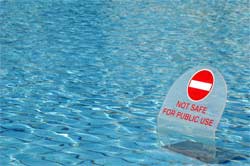
Imagine the summertime is here...the sky is blue and it's a perfect day to head to the local pool for an afternoon of sun and fun in the water. Besides the obvious dangers associated with swimming, there is a growing frequency in the safety and management of the pool water you swim in. Want to learn more? Have a quick look below...

A variety of microorganisms can be found in swimming pools and similar recreational water environments, which may be introduced in a number of ways. In many cases, the risk of illness or infection has been linked to faecal contamination of the water. The faecal contamination may be due to feces released by bathers or contaminated source water or, in outdoor pools, may be the result of direct animal contamination (e.g. from birds and rodents). Faecal matter is introduced into the water when a person has an accidental fecal release - AFR (through the release of formed stool or diarrhea into the water) or residual fecal material on swimmers' bodies is washed into the pool (CDC, 2001).
Many of the outbreaks related to swimming pools would have been prevented or reduced if the pool had been well managed. Non-fecal human shedding (e.g. from vomit, mucus, saliva, or skin) in the swimming pool or similar recreational water environments is a potential source of pathogenic organisms. Infected users can directly contaminate pool or hot tub waters and the surfaces of objects or materials at a facility with pathogens (notably viruses or fungi), which may lead to skin infections in other patrons who come in contact with the contaminated water or surfaces.
'Opportunistic pathogens' (notably bacteria) can also be shed from users and transmitted via surfaces and contaminated water. Some bacteria, most notably non-faecally-derived bacteria may accumulate in biofilms and present an infection hazard.

In addition, certain free-living aquatic bacteria and amoebae can grow in pool, natural spa or hot tub waters, in the pool or hot tub components or facilities (including heating, ventilation, and air-conditioning [HVAC] systems), or on other wet surfaces within the facility to a point at which some of them may cause a variety of respiratory, dermal or central nervous system infections or diseases.
Outdoor pools may also be subject to microorganisms derived directly from pets and wildlife. The primary water and air quality health challenges to be dealt with are, in typical order of public health priority: controlling clarity to minimize injury hazard; controlling water quality to prevent the transmission of infectious disease, and controlling potential hazards from disinfection by-products.
All of these challenges can be met through a combination of the following factors: treatment (to remove particulates, pollutants, and microorganisms), including filtration and disinfection (to remove/inactivate infectious microorganisms); pool hydraulics (to ensure effective distribution of disinfectant throughout the pool, good mixing and removal of contaminated water); addition of fresh water at frequent intervals (to dilute substances that cannot be removed from the water by treatment); cleaning (to remove biofilms from surfaces, sediments from the pool floor and particulates adsorbed to filter materials); and ventilation of indoor pools (to remove volatile disinfection by-products and radon).
Controlling clarity, the most important water quality criterion, involves adequate water treatment, including filtration. The control of pathogens is typically achieved by a combination of circulation of pool water through treatment (normally requiring some form of filtration plus disinfection) and the application of a chemical residual disinfectant to inactivate microorganisms introduced to the pool itself by, for instance, bathers. As not all infectious agents are killed by the most frequently used residual disinfectants, and as circulation through the physical treatment processes is slow, it is necessary to minimize accidental fecal releases and vomit (and to respond effectively to them when they occur) and to minimize the introduction of bather-shed organisms by pre-swim hygiene.



